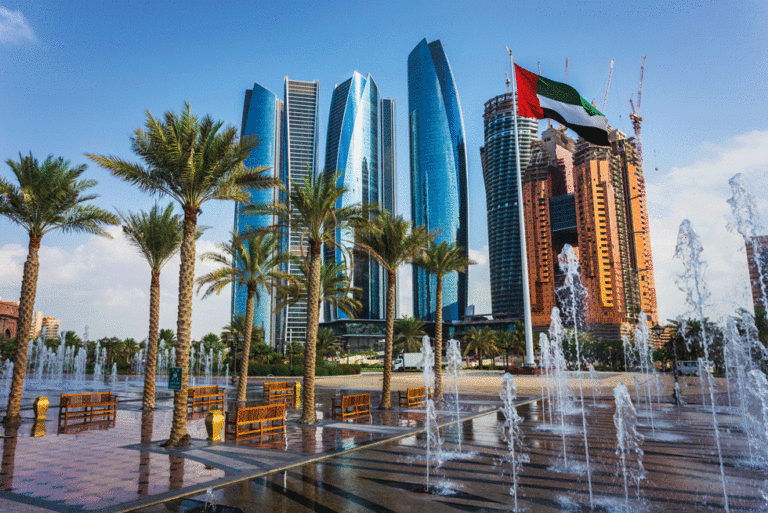UAE presses forward with an expansionary budget

Amid strengthening oil revenue and growth conditions, Abu Dhabi is coaxing the economy with a stimulus plan
The outlook for the UAE economy is buoyant upward growth, thanks in part to the recovery of oil prices and revenues, which has reversed the negative trends of 12 months ago, when production cuts dragged down economic growth.
The Washington-based IMF’s October 2018 World Economic Outlook sees overall growth strengthening to 2.9 per cent in 2018 – up from an April estimate of 1.9 per cent – before rising to 3.7 per cent in 2019.
This growth trend is expected to continue over the next few years in a climate of continually elevated oil prices, strengthening private credit and the promise of increased federal government spending.
Federal budget
 On 1 October, the UAE cabinet announced that it had approved an expansionary zero-deficit federal budget for the next three years (2019-21) with a AED180bn ($49bn) expenditure. In 2019, government spending is budgeted at AED60.3bn, a 17 per cent increase on the planned spending for 2018.
On 1 October, the UAE cabinet announced that it had approved an expansionary zero-deficit federal budget for the next three years (2019-21) with a AED180bn ($49bn) expenditure. In 2019, government spending is budgeted at AED60.3bn, a 17 per cent increase on the planned spending for 2018.
The budget for 2018 was AED51.4bn, which was a 5.6 per cent increase on the budget for 2017.
The cabinet said the focus of spending in 2019 will be on citizens’ well-being, health and education. The planned expenditure includes 42.3 per cent for community development, 17 per cent for education development and 7.3 per cent for healthcare services.
Economy adjusting
In its 2018 UAE Article IV mission conclusion, the IMF nodded its approval of the fiscal easing measures in the near term, with IMF mission leader for the UAE, Natalia Tamirisa, noting: “The UAE economy continues to adjust to a prolonged decline in oil prices since 2014. Non-oil activity remains subdued amid continued corporate restructuring, real estate overhang, and tightening financial conditions.
“Given large fiscal buffers, ample spare capacity and rising investment needs for Expo 2020 Dubai, the government has appropriately switched to providing stimulus to the economy.”
The IMF nevertheless advised a return to growth-friendly fiscal consolidation once economic growth within the emirates recovers, if the UAE wishes to transition towards long-term economic sustainability.
Inflation, which saw a sharp rise in the first quarter due to the introduction of VAT, is expected to round off at 3.5 per cent for the whole year, before easing back to 1.9 per cent in 2019 as the impact of VAT subsides.
On the fiscal side, the deficit is expected to narrow to 1.6 per cent of GDP by the end of 2018 and turn into a surplus of 0.6 per cent in 2019. The UAE’s positive current account surplus, bolstered by oil exports, is meanwhile forecast to sail clear above 7 per cent of GDP in both 2018 and 2019.
Non-oil improvements
A key indicator of performance in the non-oil sector, Emirates NBD’s UAE Purchasing Managers’ Index (PMI) rose to 55.3 in September – up from 55.0 in August and the third month in a row at or above the 55 mark – signalling an ongoing improvement of business conditions in the non-oil private sector.
Commenting on the results, head of Middle East and North Africa research at Emirates NBD, Khatija Haque, highlighted a sharp rise in output and new work in September, supported by growth in export orders. Year to date, the UAE’s PMI has averaged 55.7, which is similar to the figure for the same period last year.
 Haque cautioned, however, that employment held at below the 50 mark, indicating a negative trend for the second month running, and while the majority of firms reported no change in staffing in September, nearly 2 per cent indicated a decline in jobs last month.
Haque cautioned, however, that employment held at below the 50 mark, indicating a negative trend for the second month running, and while the majority of firms reported no change in staffing in September, nearly 2 per cent indicated a decline in jobs last month.
At the same time, the Dubai Economy Tracker Index declined to 54.4 in September, signalling the slowest rate of expansion since April. Both output and new work increased in the emirate, but at a lower rate than in August, while employment declined on average (49.2).
This was in part led by the travel and tourism sector, which witnessed its weakest growth year-to-date, declining to 51.3 in September – down from 52.9 in August and a 2018 high of 57.3 recorded in May.
In the wholesale and retail trade sector, while the overall index remained firmly in expansion territory at 55.5, the output price index declined for the fifth consecutive month to 47.8, despite a slight rise in input costs due to inflation, in an indication that the private sector is being driven to cut prices.
Optimistic UAE outlook
The business optimism component of the survey nevertheless showed that 62 per cent of the firms surveyed expected output to be higher in a year’s time, with the PMI report indicating that “firms remain highly optimistic about future output, with many citing Expo 2020 projects and marketing initiatives as reasons for expected higher output in one year’s time”.
The AED50bn ($13.6bn), three-year economic stimulus plan for Abu Dhabi, announced by Sheikh Mohammed bin Zayed in June, should meanwhile stimulate growth in the UAE’s principal emirate.
Weighing the impact of this and the UAE’s broader expansionary spending, the IMF’s Tamirisa noted: “Front-loading stimulus measures and focusing them on productive spending, consistent with the Vision 2021 goals of diversifying the economy and raising productivity, would augment their impact on growth.”


